Grade I listed war memorials in England facts for kids
There are 20 Grade I listed war memorials in England. These are very special monuments, chosen from over 3,000 listed war memorials across the country. In the United Kingdom, a listed building is a structure that is important for its history or amazing design. Listing a building helps protect it from being knocked down or changed without permission.
Buildings are put into three groups: Grade I, Grade II*, and Grade II. Grade I is for buildings that are super important and truly special. Only about 2.5% of all listed buildings are Grade I. War memorials that are Grade I are usually very beautiful and have a lot of history. Many were designed by famous artists or architects. One of the most well-known was Sir Edwin Lutyens. He designed about a third of all the Grade I war memorials! His famous works include the Cenotaph in London, where national Remembrance services are held, and the Arch of Remembrance in Leicester.
This list only includes memorials that are listed as Grade I buildings on their own. It does not include plaques on church walls or sculptures inside other listed buildings.
War memorials in England come in many shapes and sizes. They remember conflicts from hundreds of years ago. However, memorials for all soldiers, not just victorious leaders, became common after the Battle of Waterloo in 1815. The First World War (1914–1918) led to many more memorials than any other conflict. Most memorials on this list are from the First World War. Many were later updated to also remember those lost in the Second World War (1939–1945).
Contents
Special War Memorials in England
These memorials are among the most important in England. They are listed as Grade I because of their unique design, historical value, and the famous artists who created them.
What is a Listed Building?
A listed building is a structure that the government has decided is historically or architecturally important. This means it gets special protection. You can't just tear it down or change it without permission. This helps keep our history alive.
Why are War Memorials Listed?
War memorials are listed to protect them for future generations. They remind us of the sacrifices made during wars. Grade I memorials are especially important because they are considered masterpieces of design or have a very significant history.
Sir Edwin Lutyens: A Master Architect
Sir Edwin Lutyens was a very famous British architect. He designed many buildings and memorials, including a large number of war memorials. His designs are known for being strong, simple, and very moving. He created some of the most iconic war memorials in the UK and other countries.
Famous Grade I War Memorials
| Name | ID | Image | Location | Conflict | Architect or sculptor | Type | Inauguration date | Listing date |
|---|---|---|---|---|---|---|---|---|
| Port Sunlight War Memorial | 1343491 | 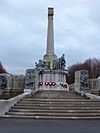 |
Port Sunlight, Merseyside | First and Second World Wars | Sir William Goscombe John | Sculptures and cross | 1921 | 20 December 1965 |
| Rochdale Cenotaph | 1084274 | 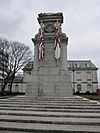 |
Rochdale, Greater Manchester | First and Second World Wars | Sir Edwin Lutyens | Cenotaph | 1921 | 12 February 1985 |
| The Arch of Remembrance | 1074786 |  |
Leicester, Leicestershire | First and Second World Wars | Sir Edwin Lutyens | Memorial arch | 1925 | 23 February 1955 |
| Liverpool Cenotaph | 1073463 |  |
Liverpool, Merseyside | First and Second World Wars | Lionel Bailey Budden, Herbert Tyson Smith, sculptor | Cenotaph | 1930 | 28 June 1952 |
| Southampton Cenotaph | 1340007 | 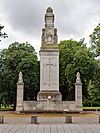 |
Southampton, Hampshire | First and Second World Wars, Malayan Emergency, Korean War, Mau Mau Uprising | Sir Edwin Lutyens | Cenotaph | 1920 | 8 October 1981 |
| The Cenotaph | 1357354 |  |
City of Westminster, London | First and Second World Wars | Sir Edwin Lutyens | Cenotaph | 1920 | 5 February 1970 |
| The Mercantile Marine First World War Memorial | 1260087 |  |
London Borough of Tower Hamlets | First World War | Sir Edwin Lutyens | Miscellaneous | 1928 | 27 September 1973 |
| Royal Artillery Memorial | 1231613 | 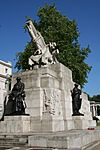 |
City of Westminster, London | First and Second World Wars | Lionel Pearson | Sculpture | 1926 | 14 January 1970 |
| Guards Memorial | 1231315 | 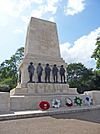 |
City of Westminster, London | First and Second World Wars | H. Chalton Bradshaw | Cenotaph with sculptures | 1926 | 14 January 1970 |
| Spalding War Memorial | 1064002 |  |
Spalding, Lincolnshire | First and Second World Wars | Sir Edwin Lutyens | Miscellaneous | 1922 | 20 November 1975 |
| "The Response" | 1186201 |  |
Newcastle upon Tyne, Tyne and Wear | First World War | Sir William Goscombe John | Sculpture | 1923 | 17 December 1971 |
| Northampton War Memorial | 1191327 | 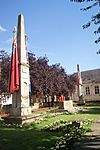 |
Northampton, Northamptonshire | First and Second World Wars | Sir Edwin Lutyens | Obelisk pair and Stone of Remembrance | 1926 | 22 January 1976 |
| Chatham Naval Memorial | 1267787 | 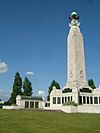 |
Chatham, Kent | First and Second World Wars | Sir Robert Lorimer | Obelisk | 1924 | 5 December 1996 |
| Plymouth Naval Memorial | 1386464 | 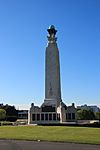 |
Plymouth, Devon | First and Second World Wars | Sir Robert Lorimer | Obelisk | 1924 | 1 May 1975 |
| Portsmouth Naval Memorial | 1386975 | 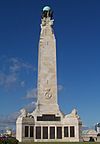 |
Portsmouth, Hampshire | First and Second World Wars | Sir Robert Lorimer | Obelisk | 1924 | 25 September 1972 |
| Preston Cenotaph | 1218458 | 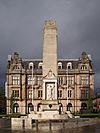 |
Preston, Lancashire | First and Second World Wars | Sir Giles Gilbert Scott | Cenotaph | 1926 | 20 December 1991 |
| Wagoners' Memorial | 1161354 | 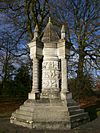 |
Sledmere, East Riding of Yorkshire | First World War | Alfred Barr | Column | 1920 | 20 September 1966 |
| Edith Cavell Memorial | 1264768 | 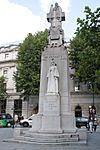 |
St. Martin's Place, London, WC2 | First World War | Sir George Frampton | Pylon with statue | 1920 | 5 February 1970 |
| Eleanor Cross, Sledmere | 1083806 | 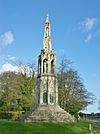 |
Sledmere, East Riding of Yorkshire | First World War | Temple Moore | Cross | 1920 | 20 September 1966 |
| Statue of Captain Albert Ball, Nottingham Castle | 1246929 |  |
Nottingham Castle Gardens, Nottingham | First World War | Edwin Alfred Rickards and Henry Poole | Statue | 1921 | 12 July 1972 |

